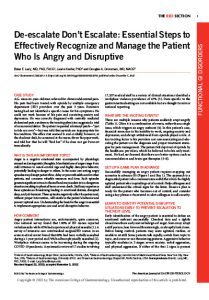De-escalate Don’t Escalate: Essential Steps to Effectively Recognize and Manage the Patient Who Is Angry and Disruptive
Brian E. Lacy, MD, PhD, FACG1, Laurie Keefer, PhD2 and Douglas A. Drossman, MD, MACG3
Am J Gastroenterol 2022;00:1–3. https://doi.org/10.14309/ajg.0000000000002090; published online December 7, 2022

CASE STUDY
A.G. was a 42-year-old man referred for chronic abdominal pain. His pain had been treated with opioids by multiple emergency department (ED) providers over the past 3 years. Extensive testing had not identified a specific cause for his symptoms. He could not work because of his pain and coexisting anxiety and depression. He was correctly diagnosed with centrally mediated abdominal pain syndrome; the treating physician suggested a trial of a neuromodulator. The patient requested a fentanyl patch—“just to tide me over”—but was told that opioids are inappropriate for his condition. The office visit seemed to end cordially; however, at the checkout desk, he screamed at the nurse, threw his paperwork, and told her that he will “find her” if he does not get Percocet immediately.
WHY IS THIS AN IMPORTANT TOPIC?
Anger is a negative emotional state accompanied by physiologic arousal and antagonistic thoughts. Manifestations of anger range from mild irritation to out-of-control rage and highly disruptive behavior, potentially leading to danger to others. In the acute care setting, angry episodes may disrupt patient flow, delay or prevent healthcare for other patients, and consume valuable resources and time. Such episodes generate significant stress to the staff and may escalate into a dangerous situation resulting in physical harm or even death. Staff may experience these episodes as threatening, leading to emotional distress, disrupted sleep, and job burnout. These episodes negatively affect the patient and, without proper intervention, will reinforce the patient’s behavior and prevent optimal care. Understanding the basis for the anger is essential to implement appropriate care and avoid disruptive behavior.
HOW COMMON?
Angry patient interactions are, unfortunately, quite common. One national survey found that 100% of ED nurses reported verbal assaults while 83% had \ experienced physical assaults (1). A survey of intensive care unit/medical surgical/ED nurses in an acute medical center found that 88% had been verbally assaulted during a 1-year period and 74% had been physically assaulted (2). Workplace violence seems to be increasing during the ongoing COVID-19 pandemic. Asystematic review of 17 studies involving 17,207 medical staff in a variety of clinical situations identified a workplace violence prevalence of 47% (3). Data specific to the gastrointestinal setting are not available but are thought to mirror national reporting.
WHAT ARE THE INCITING EVENTS?
There are multiple reasons why patients suddenly erupt angrily (Table 1). Often it is a combination of events, rather than a single issue, which triggers an angry outburst (4). In this patient’s case, financial stress due to his inability to work, ongoing anxiety and depression, and abrupt withdrawal from opioids played a role. A key inciting factor is his providers not communicating and educating the patient on the diagnosis and proper treatment strategies for pain management. The patient felt deprived of opioids by the healthcare providers, which he believed to be his only treatment. He had not learned that there are better options such as neuromodulators and brain-gut therapies (5–8).
SET UP A GAME PLAN IN ADVANCE
Successfully managing an angry patient requires mapping out scenarios in advance (9) (Figure 1 and Box 1). The approach to a disgruntled patient who communicates well differs from the highly agitated patient who is spiraling out of control. Help colleagues and staff understand the critical signs for the latter. Ensure a plan is ready for the patient who becomes out of control, and consider using a keyphrase or buzzword to alert colleagues to call security.
LEARN TO IDENTIFY POTENTIAL DISRUPTIVE SITUATIONS EARLY TO PREVENT ESCALATION TO THE NEXT LEVEL
Early identification of the angry patient is essential to defuse an emotional outburst successfully. Clenched fists and a tightly closed mouth are early nonverbal signs of anger. Some may adopt a stiff posture, lean forward threateningly, or abruptly look down. Before losing control, patients may seem agitated, restless, or unable to sit still. Some patients talk rapidly, switch from topic to topic, and swear or use threatening gestures. Aggressive behavior typically escalates in 3 stages: severe anxiety, verbal aggression, and physical aggression. If either of the first 2 signs is present when the patient is in the examination room, keep the door open; ensure no provider is left alone; and let the staff know that security may need to intervene.
MANAGEMENT
De-escalating a potentially dangerous situation early takes advanced planning. Rehearsing a scenario with a colleague in advance is vital. Knowing what not to do is as important as knowing what to do. Key elements include recognizing severe anxiety, which is usually the first stage before the behavior becomes disruptive (Figure 1 and Box 1). A severely anxious patient who has not progressed to the second phase, verbal aggression, can often be calmed down by sending a positive nonverbal signal by sitting nearby (but out of reach) while maintaining a relaxed, open position. Standing above the patient and looking down can be construed negatively. If the patient is speaking, do not interrupt. At the appropriate time, speak calmly, slowly, and clearly. Let the patient know, “You seem tense, frustrated, or anxious today.” If they acknowledge this, ask “why are you feeling that way?” or “can you tell me more about that?” The next few minutes spent listening may prevent progression to the next level. If the patient is talking loudly or yelling, calmly state, “I’d like to understand you better. May I ask if you could lower your voice?” If there is a verbal or physical signal that violence may ensue, then coolly state, “I need to be excused for a minute, and I will return later.” At this point, alert colleagues and staff that you may need assistance, and if appropriate, notify security. However, if the patient can maintain a controlled dialog, then acknowledge and validate the patient’s feelings in an empathic manner. For example, “I can understand why all of these things would make you angry.” Or “I can understand why you would be so upset given everything you have gone through.” Again, listen carefully without interrupting; this can be immensely therapeutic. At an appropriate time, set up an arrangement to resolve the problem. Do not suggest a quick fix; angry situations are complex and are not solved with a single intervention, “Let’s take some time and see how we might be able to work together on this.” RESOLUTION After an episode, it is important to debrief the staff. Determine whether the approach used worked. Ask whether a new approach is required, and revise accordingly (9–11). Importantly, assess whether the incident has caused psychological distress to the staff and then treat appropriately (e.g., refer to human resources and counseling). Whether to discharge an angry patient from the provider’s practice is complicated because multiple medical and legal issues are involved. If the episode was mild, quickly defused, and did not involve physical threats or violence and if the provider believes that a therapeutic relationship can continue, there is no need to discharge the patient. However, suppose the episode escalated to threats or violence. In that case, the patient should be released from the practice with the institution’s legal staff assistance.
CASE CONCLUSION
Dr. T was called and calmly asked whether they can return to the office to address A.G.’s concerns privately (with the door left open). He actively listened to A.G.’s concerns without interrupting. He acknowledged that the pain is real and empathized with his symptoms and his long healthcare journey. After the patient calmed down, Dr. T asked about the patient’s concerns and goals. Next, he discussed the diagnosis of centrally mediated abdominal pain syndrome and explained the basis for his pain through disrupted gut-brain neural control (12). Dr. T. acknowledged that A.G. felt the need to be on opioids for pain relief, noting that he believed he has no other options; however, there are better treatment strategies. Dr. T. then reviewed better long-term pain relief solutions and reassured the patient that he will be available to work with him on his care. He proposed an integrated care plan involving a psychologist (to focus on brain-gut behavioral therapy) and the use of a neuromodulator (4–8). He reassured the patient that he has successfully treated many similar patients with this approach and that he will see him again in follow-up. He asked the patient whether he has any questions and again reviewed the plan. His encounter at the checkout desk is uneventful.
CONFLICTS OF INTEREST
Guarantor of the article: Brian Lacy, MD, PhD, FACG.
Specific author contributions: All authors contributed equally to the development, research, and writing and editing of the manuscript.
Financial support: No financial support of any kind was provided for the development and writing or editing of this manuscript.
Potential competing interests: None to report.
Read the full publication with supporting tables and figures
Authors & Rome Foundation Board Members



